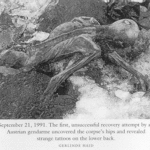Anthropology

There's a federal law that says Native American bones held by museums or other institutions have to be returned to the tribe they are associated with - if the tribe can prove the bones are in fact associated with them. Nature is reporting that the University of California is planning, over the objections of researchers, on handing over 10,000 year old bones to the Kumeyaay tribe, which claims the bones came from one of their sacred burial ground.
If the bones were clearly linked to the tribe, few people would object to handing the bones over; the problem is, the Kumeyaay tribe's claims are…

A new dating method found that "Peking Man" is around 200,000 years older than previously thought. So how did he adapt to the cold of even a mild glacial period?
The Zhoukoudian, China, site of the remains of Homo erectus, commonly known as "Peking Man", was found to be 680,000-780,000 years old. Earlier estimates put the age at 230,000-500,000 years old.
Homo erectus is considered to be the ancestor species to humans and the first species that left Africa and moved into Asia. The "Peking Man" site, discovered in the late 1920s, was among the first found for Homo erectus and shaped the…

Not only have horses been domesticated longer than we thought but they were also milked, says an article in Science.
The researchers have traced the origins of horse domestication back to the Botai Culture of Kazakhstan circa 5,500 years ago, about 1,000 years earlier than thought and about 2,000 years earlier than domestic horses are known to have been in Europe. Their findings strongly suggest that horses were originally domesticated, not just for riding, but also to provide food, including milk.
Through extensive archaeological fieldwork and subsequent analysis, using new techniques, the…

To the historian, English is a fascinating language. Unlike most of the languages of Europe, it underwent an almost complete makeover following the Norman invasion (1066 and All That). As a result, although or basic words and grammar are basically like German and especially Dutch, the lion’s share of our vocabulary is from French and Latin.
However, if you read History in English Words by Owen Barfield, you will be taken back to a time before English, when a group of warrior tribes spread out over Europe and North India, spreading their languages even more effectively than…

When Evo Morales, Bolivia's first president of Indian origin, was appointed in 2006 he initiated a "decolonising revolution." Now, in a new thesis in social anthropology at the University of Gothenburg, Anders Burman examines how the government policy for decolonization has been interwoven with the rituals and cosmology of the indigenous population.
For the indigenous population in the Bolivian Andes, colonialism was not something that was consigned to history when Bolivia was founded. Their exploitation and marginalization simply took on new forms.
Eyebrows are sometimes raised…

Ancient footprints show that some of the earliest humans walked like us and did so on anatomically modern feet 1.5 million years ago.
This anatomical interpretation is the conclusion of Rutgers Professor John W.K. Harris and an international team of colleagues. Harris is a professor of anthropology, a member of the Center for Human Evolutionary Studies and director of the Koobi Fora Field Project.
Harris is also director of the field school which Rutgers University operates in collaboration with the National Museums of Kenya. From 2006 to 2008, the field school group of mostly American…

Researchers at Ben-Gurion University of the Negev (BGU) in Beer-Sheva have determined that the once prevalent custom of female genital mutilation (FGM) among the Bedouin population in the Negev has virtually disappeared.
FGM, also known as "female circumcision" or "female cutting," is still practiced in many cultures around the world. The World Health Organization has made the eradication of female genital mutilation a major goal in Africa, Asia and Australia, though why the UN doesn't care about men is subject to speculation.
Bedouins have become more westernized since Israel's…

Contrary to the TV sitcom where the wife experiencing strong labor pains screams at her husband to stay away from her, women rarely give birth alone. Today, there are typically doctors, nurses and husbands in hospital delivery rooms, and sometimes even other relatives and friends. Midwives often are called on to help with births at home.
Assisted birth has likely been around for millennia, possibly dating as far back as 5 million years ago when our ancestors first began walking upright, according to University of Delaware paleoanthropologist Karen Rosenberg. She says that social…

A mystery is solved for me today: the "flies" on my rice paper plant flowers are the wild native bees that make honey! The ancients of the Americas hunted for the honey of the stingless, domestic-fly-size bees, Trigonae and Meliponoae, for example, to sweeten their cocoa drinks long before the arrival of Columbus.
In "Evidence of cacao use in the Prehispanic American Southwest," Patricia Crown and Jeffrey Hurst report finding theobromine* (a biomarker for cacao, also known as xantheose) in fragments of tall ceramic mugs from Pueblo Bonito in Chaco Canyon, New Mexico, USA.…

Investigators from Ludwig-Maximilians-Universität München and a Bolzano colleague have written another chapter in a murder case over 5,000 years old. New investigations reconstructed the chronology of the injuries that Oetzi, the glacier man preserved as a frozen mummy, received in his last days.
It is the oldest ice mummy ever found. Oetzi, the man from the Neolithic Age, is giving science critical information about life more than 5000 years ago, not least from his equipment. His copper axe, for example, reveals that metalworking was already much more advanced in that era than was…